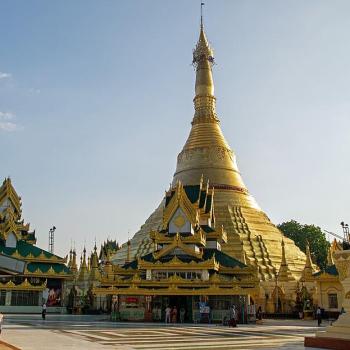 |
|
So much for “quietist”
|
Ever since London was awarded the 2012 Olympic Games in 2005 (a day before the 7/7 bombings), the area around the proposed Olympic site in East London has been subject to a flurry of construction activity and proposals. Part of the rationale for the selection itself was to inject sorely needed economic activity and infrastructure into the neglected area. As such, the growing pains have prompted the usual debates about gentrification, allocation of funds, and the virtues of architectural context.
But none of this activity has stirred up as much controversy as the proposed Abbeymills Mosque, slated by its critics as a “mega-mosque” with dire implications for everything from aesthetics to national security. Many of the statistics used in opposition to the mosque have been wildly inflated, with allegations of 100,000+ capacities and the use of £100 million of taxpayers money. In reality, the mosque has a capacity of 12,000 (only 2,000 more than the current largest) and no use of public funds, as verified by London’s mayor Ken Livingstone, one of the mosque’s supporters. A school for 500 students is also part of the project.
Behind the numbers, the primary motivation for opponents is the group behind the mosque, the Tablighi Jamaat. Founded in India nearly a century ago with a claimed 70-80 million followers worldwide, the Tablighi Jamaat is a revivalist group with no formal hierarchy and a focus on practicing (or less than practicing, in their view) Muslims. Its current mosques, or markaz, in Dewsbury (their European headquarters) and London are overflowing with worshippers, which prompted the land purchase for Abbeymills even before the Olympics were awarded. For a group described as “quietist,” the scandal has been a splash of cold water.
Opponents cite the crossed paths of a number of extremists with Tablighi Jamaat, including Mohammed Siddique Khan (from the 7/7 attacks) and Kafeel Ahmed (from the failed Glasgow attack this year), though they have provided nothing substantive. Neither were formal members of the group at the time of their terror attacks, nor did they appear influenced by doctrines espousing violence or political activity (Tabligh has none). Elsewhere, there are charges that the group seeks to convert all of Britain, though any evangelical group would likely claim the same. The Tablighi Jamaat are many things – apolitical, conservative (and if you have them as uninvited houseguests, mildly annoying). But extremists or terrorists – probably not.
An internet petition against the mosque signed by over 250,000 was rebutted by the government for its “untrue information,” though it acknowledged raised tensions if the scale of the mosque was not kept in check. Tablighi Jamaat claims the organiser of a similar petition of 2,500 by Muslims (driven primarily by sectarian sentiment) now supports the mosque. Links to Saudi funding for the mosque have been denied (though the Saudi-funded Muslim World League did contribute to the group’s Dewsbury headquarters).
As for the building itself, the architects for the initial scheme, which may have compounded the confusion of its scale, were sacked earlier this year, possibly due to the heightened media exposure. During the time this scheme was made public, there was insufficient effort made by Tablighi Jamaat to defend or explain the mosque. Said architect Ali Mangera, “They should have responded to the criticism by speaking to the press and public instead of remaining silent for the last three years.”
It is this public silence, a characteristic of the low-lying group, combined with its decentralised authority that has led to a lacklustre defense of the project. At the first public meeting on the issue last month, official representatives failed to show up to a public meeting to debate the mosque. A local councillor and leading opponent, Alan Craig, was left to vent against the group, defended only by an activist whose ties to the Tablighi Jamaat were severed along with Mangera.
Still, there are signs the group may learn constructively from the experience. A new, high-profile architect has been commissioned for a revised (and presumably more sensitive) scheme, with a planning application expected in 2008. A more detailed explanation of the mosque and the motivations for building it can now be seen on the mosque’s website. And video rebuttals have been created to counter Craig’s own YouTube salvos.
“We were never going to have a 70,000 or 80,000-capacity mosque – that’s Wembley Stadium,” notes Tabligh member Abdul Rashid Bhatti. “This is 18 acres. It was never going to be funded by public money … We feel threatened and saddened by the way the project has been hijacked.” Forced by circumstance, the group promises a more active participation in public discourse on the mosque in the future, which could be the beginning of an increased public interaction and a tempering of the group’s isolationist views.
Zahed Amanullah is associate editor of altmuslim.com. He is based in London, England.














